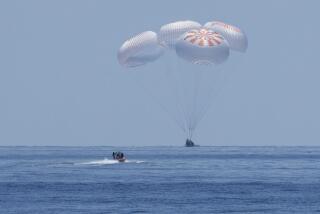New Shuttle Crew Expects Foam Debris and Isn’t Worried
- Share via
CAPE CANAVERAL, Fla. — Crew members chosen for NASA’s second space shuttle mission since the 2003 Columbia disaster said Friday that they were confident that fuel-tank changes would result in a safe, but not debris-free, liftoff.
The modifications were ordered after shuttle Discovery’s fuel tank shed large pieces of insulating foam during July’s launch, the first mission since the Columbia accident -- which was caused by falling foam.
“The program has never advertised that we would never lose any foam,” said Steven W. Lindsey, the commander of the next crew, which will fly on Discovery.
“We will lose foam on this flight, just like every other. The key is that the foam we do lose is small enough size that it can’t hurt us if it hits the vehicle.”
The other shuttle crew members are pilot Mark E. Kelly, flight engineer Lisa M. Nowak, Michael E. Fossum, Stephanie D. Wilson and Briton Piers J. Sellers.
Managers hope to launch Discovery in May, but several hurdles must be cleared in the next few weeks to prevent a postponement until the next launch opportunity in July. Among them, the redesigned fuel tank still must pass wind-tunnel tests and other engineering assessments, and Kennedy Space Center workers must inspect and replace cloth fillers between the ceramic heat-shielding tiles on Discovery’s belly.
The Discovery crew is to fly to the International Space Station on a 12-day mission to deliver cargo and transport Thomas Reiter, a German, to join the station’s two-man crew.
The shuttle crew, as in the previous mission, will spend at least a full day inspecting the shuttle’s heat shield in orbit, using a new 50-foot sensor-laden boom attached to the ship’s cargo-bay crane.
The crew also plans to test techniques and materials to repair shuttle wing panels and tile damage.
More to Read
Sign up for Essential California
The most important California stories and recommendations in your inbox every morning.
You may occasionally receive promotional content from the Los Angeles Times.












